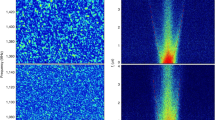Abstract
Studies of asteroid families—groups of asteroids that formed from the fragmentation of larger bodies—are of broad interest to solar system researchers because they can provide insights into collisional processes, as well as the interior structures, strengths, and compositions of asteroids. It is generally accepted that members of the Koronis family were created by collisional disruption of a homogeneous parent body1 and therefore share the same formation age and subsequent collisional history. The temporal variations in observed brightnesses of the Koronis family members (a consequence of their rotation) are, however, larger than expected2. Preferential alignment of spin vectors had been proposed2 as a possible explanation, but recent modelling3 predicted that family formation yields random spin vectors among the resulting fragments. Both hypotheses have been untested by observations. Here I show that the actual distribution of spin vectors among the largest members of the Koronis family falls within markedly nonrandom ‘spin clusters’. Reconciling models of family formation and evolution with the unexpected alignments of spin obliquities and correlations with spin rates presents a new challenge in understanding asteroid collisional processes.
This is a preview of subscription content, access via your institution
Access options
Subscribe to this journal
Receive 51 print issues and online access
$199.00 per year
only $3.90 per issue
Buy this article
- Purchase on Springer Link
- Instant access to full article PDF
Prices may be subject to local taxes which are calculated during checkout



Similar content being viewed by others
References
Chapman, C. R., Paolicchi, P., Zappalà, V., Binzel, R. P. & Bell, J. F. in Asteroids II (eds Binzel, R. P., Gehrels, T. & Matthews, M. S.) 386–415 (Univ. Arizona Press, Tucson, 1989)
Binzel, R. P. Collisional evolution in the Eos and Koronis asteroid families: Observational and numerical results. Icarus 73, 303–313 (1988)
Michel, P., Benz, W., Tanga, P. & Richardson, D. C. Collisions and gravitational reaccumulation: Forming asteroid families and satellites. Science 294, 1696–1700 (2001)
Zappalà, V., Bendjoya, Ph., Cellino, A., Farinella, P. & Froeschle, C. Asteroid families: Search of a 12,487-asteroid sample using two different clustering techniques. Icarus 116, 291–314 (1995)
Binzel, R. P. A photoelectric survey of 130 asteroids. Icarus 72, 135–208 (1987)
Slivan, S. M. Spin-Axis Alignment of Koronis Family Asteroids PhD thesis, Massachusetts Institute of Technology (1995)
Slivan, S. M. & Binzel, R. P. Forty-eight new rotation lightcurves of 12 Koronis family asteroids. Icarus 124, 452–470 (1996)
Slivan, S. M. et al. Spin vectors in the Koronis family: Comprehensive results from two independent analyses of 213 rotation lightcurves. Icarus (submitted).
Drummond, J. D., Weidenschilling, S. J., Chapman, C. R. & Davis, D. R. Photometric geodesy of main-belt asteroids. II. Analysis of lightcurves for poles, periods, and shapes. Icarus 76, 19–77 (1988)
Kaasalainen, M. & Torppa, J. Optimization methods for asteroid lightcurve inversion. I. Shape determination. Icarus 153, 24–36 (2001)
Kaasalainen, M., Torppa, J. & Muinonen, K. Optimization methods for asteroid lightcurve inversion. II. The complete inverse problem. Icarus 153, 37–51 (2001)
Binzel, R. P. et al. Asteroid 243 Ida: Ground-based photometry and a pre-Galileo physical model. Icarus 105, 310–325 (1993)
Davies, M. E. et al. The north pole direction and the control network of the asteroid 243 Ida. Bull. Am. Astron. Soc. 26, 1154–1155 (1994)
Miller, I. & Freund, J. E. Probability and Statistics for Engineers (Prentice-Hall, Englewood Cliffs, New Jersey, 1977)
Belton, M. J. S. et al. First images of asteroid 243 Ida. Science 265, 1543–1547 (1994)
Marzari, F., Davis, D. & Vanzani, V. Collisional evolution of asteroid families. Icarus 113, 168–187 (1995)
Rubincam, D. P. Radiative spin-up and spin-down of small asteroids. Icarus 148, 2–11 (2000)
Bowell, E., et al. in Asteroids II (eds Binzel, R. P., Gehrels, T. & Matthews, M. S.) 524–556 (Univ. Arizona Press, Tucson, 1989)
Landolt, A. U. UVBRI photometric standard stars around the celestial equator. Astron. J. 88, 439–460 (1983)
Acknowledgements
I thank R. Binzel for advice and encouragement, and M. Kaasalainen, L. Crespo da Silva, M. Lyndaker and M. Krc̆o for contributions at various stages of this work.
Author information
Authors and Affiliations
Corresponding author
Ethics declarations
Competing interests
The authors declare that they have no competing financial interests.
Rights and permissions
About this article
Cite this article
Slivan, S. Spin vector alignment of Koronis family asteroids. Nature 419, 49–51 (2002). https://doi.org/10.1038/nature00993
Received:
Accepted:
Issue Date:
DOI: https://doi.org/10.1038/nature00993
This article is cited by
-
The Dawn Gravity Investigation at Vesta and Ceres
Space Science Reviews (2011)
-
Spun in the sun
Nature (2007)
-
The vector alignments of asteroid spins by thermal torques
Nature (2003)
-
Spin control for asteroids
Nature (2003)
Comments
By submitting a comment you agree to abide by our Terms and Community Guidelines. If you find something abusive or that does not comply with our terms or guidelines please flag it as inappropriate.



